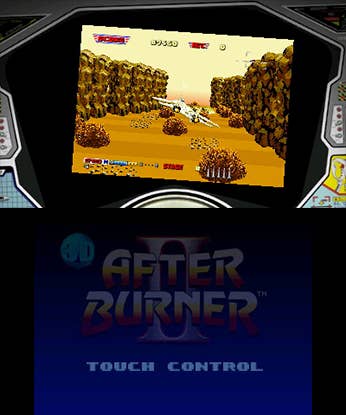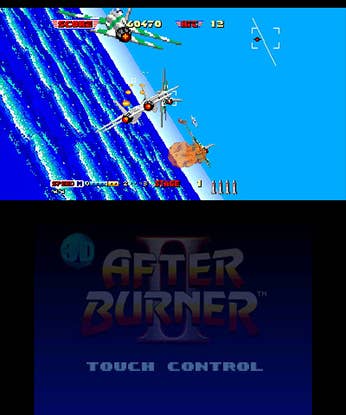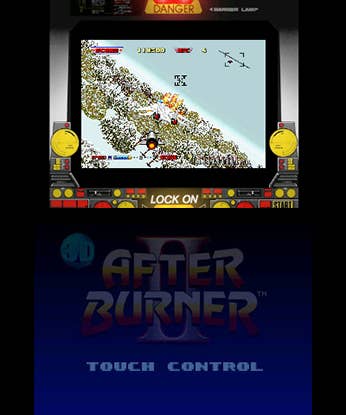3D Afterburner II 3DS Review: Too close for missiles, I'm switching to guns
Sega's classic, big-cabinet coin-op gets the full M2 treatment as it flies in on 3DS.
This article first appeared on USgamer, a partner publication of VG247. Some content, such as this article, has been migrated to VG247 for posterity after USgamer's closure - but it has not been edited or further vetted by the VG247 team.
Hailing from an era when 3D games were created by hurling mind-boggling numbers of high-speed, scalable sprites at a screen, Afterburner II was released in 1987 as a minor upgrade to the original, adding a simple throttle control and a trio of extra stages (making 23 in total).

It's this version that M2 has chosen to port to 3DS, and it must be said that they've done a sterling job. Right from the start, it's clear that this is an exacting translation that goes above and beyond being just a good port. It adds deft touches and detail that show the utmost respect for Sega's big-name coin-op.
If you've never seen it before, Afterburner II is a rail shooter in which you fly a barrel-rolling F-14D Tomcat (trademark of Northrop Grumman Systems Corp no less) top gun style into battle against wave after wave of enemy aircraft. Armed with an unlimited supply of bullets and a finite number of air-to-air missiles, the objective is simple – dodge the endless barrage of ordnance hurled at you by enemy aircraft, take down as many foes as possible, and, occasionally, fly down narrow canyons, making sure you don't make contact with the rocky walls for reasons that should be fairly obvious.

The mechanics of shooting down enemies involves moving your on-screen reticle over an aircraft and either letting rip with your guns (which requires precision aim), or launching one of your missiles – which is basically a fire-and-forget guaranteed hit. So it's missiles all the way, then? Nope. The problem is that not only are they in limited supply, they also leave huge smoke trails, making it almost impossible to see incoming missiles if you launch several at once. This ultimately means striking the right balance between gun and missile usage, which is where the heart of the game's challenge lies.
As the player progresses, the speed and number of enemy squadrons increase, which requires constant maneuvering to avoid being shot down – including barrel rolling out of the way of particularly nasty missile clusters. It's all very intense, but fortunately there are a few very short breathers along the way, with the Tomcat mid-air rearming and occasionally landing at combat airfields and carriers along the way to the destination at the end of the 23rd level. And you certainly need those short breaks. Afterburner II is an old-school arcade game designed first and foremost to relieve you of as many of your quarters as possible. Which means it's therefore pretty damn hard, and it'll test your skills to their limits. Unless, of course, you chicken out and play on the lowest difficulty setting, in which case, your skills will still be tested, but you'll just get a bunch more lives and continues to burn through.

One of the things that makes this port impressive is the detailing. There are four different screen surrounds, representing the quartet of Afterburner II cabinet styles (for the record, two sit-in versions, and a pair of upright cabinets). The screen proportions can also be adjusted from full with almost no surround to a much smaller size with a larger portion of the screen surround. However, I did find this mode difficult to play on my smaller, original 3DS, because the screen size is especially tiny. On a 3DS XL this won't be as much of a problem, however.
What I do like is the way that the screen tilts within the main display. Even when the biggest screen option is chosen, it tilts from left to right to emulate the side-to-side rocking of a sit-in cabinet. It's completely superfluous to the game, but it's just another one of the neat touches that makes this game feel so meticulously ported.
Options are another area where much love has been lavished. From being able to set up the controls and buttons however you like to a music player that lets you enjoy every classic 80's PCM slap bass and rock riff in the game – and tweak them using a built-in equalizer – 3D Afterburner II is as complete a port as you could hope for.
One addition that goes beyond the original Afterburner II is a "Special" mode that's unlocked when you finish the normal version of the game. Inspired by Afterburner Climax, this mode features a burst meter that you fill up by taking down enemies. Once full, it can be activated to briefly put the game into slow motion – ideal for those end-of-level moments of pure mayhem when you're barrel rolling through swarms of air-to-air missiles and have an enemy bogey on your tail.
3D Afterburner II is an excellent addition to the ever-growing Sega 3D collection. Its high challenge, short, bursty, arcade gameplay isn't for everyone, but if you feel nostalgic for Sega's fighter combat game, or simply want to experience a classic slice of mid-80's sprite-scaled madness and mayhem, six bucks is a pretty reasonable price of admission – especially when you consider just how finely crafted a package this really is.
VisualsVast amounts of scaling sprites deliver an authentic 80's feel.
SoundClassic period tunes, and the game even includes its own equalizer.
InterfaceA comprehensive series of options let you set up the game numerous different ways.
Lasting AppealIt's a simple arcade game, but the perfect thing to dip in and out of when you have a few spare moments.
ConclusionA meticulously ported slice of classic 80's arcade action. Without doubt the best version of Afterburner II around - and that includes the original arcade game.
